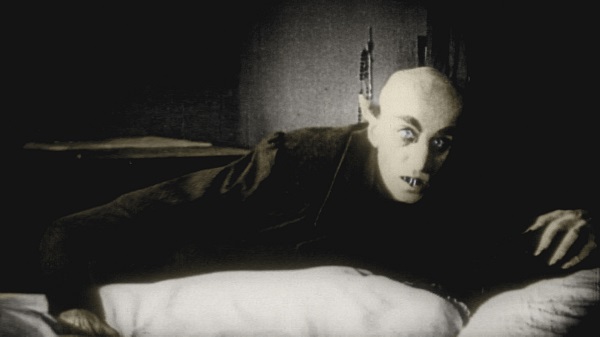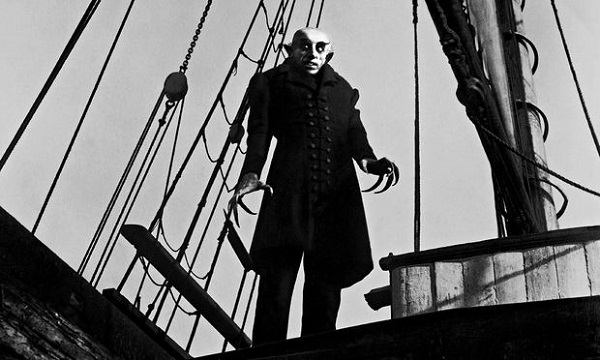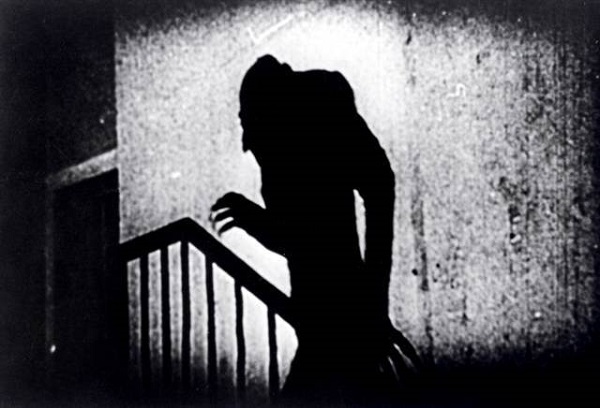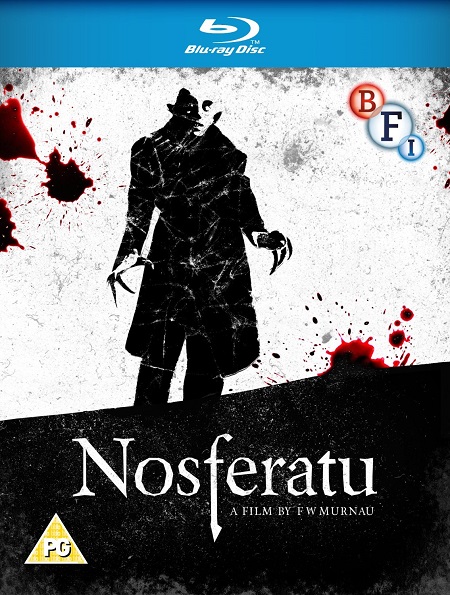BFI Blu-ray Re-release – Nosferatu: A Symphony of Horror
"The Dark of German Expressionism"
The German expressionist movie
Nosferatu: A Symphony of Horror is often regarded as one of the great movies of the silent era and it has been restored for a Blu-ray re-release by the British Film Institute (BFI).
In the fictional German city of Wisburg in 1838, a young real estate agent and lawyer Hutter (Gustav von Wangenheim) is sent to Transylvania to close a deal with the mysterious Count Orlok (Max Schreck). But Orlok is a feared man in his homeland and unknown to Hutter, his host is a vampire, the living dead who feeds upon the blood of men. Hutter has to race back to Wisburg before Orlok arrives as the vampire spreads a pestilence across Europe.
 Nosferatu
Nosferatu is an adaptation of Bram Stoker's
Dracula in all but name, to the point where his widow Florence Balcombe successfully sued for copyright infringement and the courts demanded that all prints of the film should be destroyed. Obviously, copies of
Nosferatu survived and it has been seen as an important milestone like
Birth of a Nation,
Metropolis and
Battleship Potemkin. It is a visually distinctive movie and the BFI restoration recovered the use of different color filters to symbolize when the action is taking place, gold for day, blue and purple for night.
Nosferatu certainly needed this touch because many of the night scenes were filmed during the day - Orlok's shadow was clearly visible during these scenes.
Nosferatu has some iconic images in silent cinema, including the famous moment when Orlok's shadow creeps up the stairs near the end of the movie. It is an effective use of shadows to create a creepy atmosphere. Director F. W. Murnau took a experimental approach when making
Nosferatu, particularly when Hutter goes to Transylvania, known as the Land of Ghosts. When Hutter enters into Orlok's territory the movie turns very surreal, using sped up footage, over-exposed film, time lapse photography and slow motion techniques - it looks very quaint now, but back in 1922 it would have looked very unsettling.
Murnau and his production team do give Max Schreck a very famous look as Orlok, having a hooked nose, pointed ears, a bald head and long fingers and fingernails he has another worldly look to him. Schreck performed with deliberately slow movements and had very expressive eyes which was needed for a silent film. Other characters were also given these exaggerated features, the coachman had such a pointy nose he looked like Mr. Burns from
The Simpsons and the broker Knock (Alexander Granach) was given a hunchback, a bald head with unkempt hair on his temple and laughs maniacally when he thinks about the prospect of making money.
 Nosferatu
Nosferatu had a very heavy use of foreshadowing. Hutter's wife Ellen (Georg H. Schnell) is so angelic she first appears playing with a kitten and asks her husband why he even killed flowers for her. When Hutter arrives into Transylvania it sets up a world of scared peasants who fear supernatural beings in the area and the outsider dismissing these stories as silly superstitions - a trope that became popular with the genre.
Although
Nosferatu is an unofficial adaptation of
Dracula and considered one of the best adaptations, there are changes from the source material. Aside from the obvious changing of the setting from England to Germany and the character names the biggest change
Nostferatu makes is introducing the plague subplot, that everywhere Orlok goes the plague follows, causing panic in Wisbung. This subplot has often been interpreted as a response to the 1918 flu pandemic that killed between 50 million to 100 million people. Another major change is the Van Helsing type character in
Nosferatu was so minor that he could have been cut out and it would not have made any difference.

The BFI restoration recruited James Bernard to compose a new score. Bernard composed music for Hammer Films, including some of Christopher Lee's "Dracula" movies. Bernard's score does the job, being soft and sweet for the romantic moments between very deep and imposing when Orlok creeps about and prepares to strike.
Nosferatu's status as a cinematic milestone and its artistic merits are undisputed. It was an experimental movie for its time, but it has not aged as well as
Metropolis and
Battleship Potemkin and as a horror movie it is not scary.
 Special Features:
Special Features: The BFI Blu-ray comes with a 30 minute interview with author Christopher Frayling talking about
Nosferatu's production, the influence of German Folklores, German Expressionism and Romantic Movements and the influences of the influenza epidemic and the political chaos of the Weimar Republic. It also comes with two short films, the 1904 ghost story
The Mistletoe Bough and French documentary
Le Vampire about the South American Vampire Bat.
Pros
- An excellent performance by Max Schreck
- The mark-up on Schreck
- The surreal look of Transylvania
 Nosferatu is an adaptation of Bram Stoker's Dracula in all but name, to the point where his widow Florence Balcombe successfully sued for copyright infringement and the courts demanded that all prints of the film should be destroyed. Obviously, copies of Nosferatu survived and it has been seen as an important milestone like Birth of a Nation, Metropolis and Battleship Potemkin. It is a visually distinctive movie and the BFI restoration recovered the use of different color filters to symbolize when the action is taking place, gold for day, blue and purple for night. Nosferatu certainly needed this touch because many of the night scenes were filmed during the day - Orlok's shadow was clearly visible during these scenes.
Nosferatu has some iconic images in silent cinema, including the famous moment when Orlok's shadow creeps up the stairs near the end of the movie. It is an effective use of shadows to create a creepy atmosphere. Director F. W. Murnau took a experimental approach when making Nosferatu, particularly when Hutter goes to Transylvania, known as the Land of Ghosts. When Hutter enters into Orlok's territory the movie turns very surreal, using sped up footage, over-exposed film, time lapse photography and slow motion techniques - it looks very quaint now, but back in 1922 it would have looked very unsettling.
Murnau and his production team do give Max Schreck a very famous look as Orlok, having a hooked nose, pointed ears, a bald head and long fingers and fingernails he has another worldly look to him. Schreck performed with deliberately slow movements and had very expressive eyes which was needed for a silent film. Other characters were also given these exaggerated features, the coachman had such a pointy nose he looked like Mr. Burns from The Simpsons and the broker Knock (Alexander Granach) was given a hunchback, a bald head with unkempt hair on his temple and laughs maniacally when he thinks about the prospect of making money.
Nosferatu is an adaptation of Bram Stoker's Dracula in all but name, to the point where his widow Florence Balcombe successfully sued for copyright infringement and the courts demanded that all prints of the film should be destroyed. Obviously, copies of Nosferatu survived and it has been seen as an important milestone like Birth of a Nation, Metropolis and Battleship Potemkin. It is a visually distinctive movie and the BFI restoration recovered the use of different color filters to symbolize when the action is taking place, gold for day, blue and purple for night. Nosferatu certainly needed this touch because many of the night scenes were filmed during the day - Orlok's shadow was clearly visible during these scenes.
Nosferatu has some iconic images in silent cinema, including the famous moment when Orlok's shadow creeps up the stairs near the end of the movie. It is an effective use of shadows to create a creepy atmosphere. Director F. W. Murnau took a experimental approach when making Nosferatu, particularly when Hutter goes to Transylvania, known as the Land of Ghosts. When Hutter enters into Orlok's territory the movie turns very surreal, using sped up footage, over-exposed film, time lapse photography and slow motion techniques - it looks very quaint now, but back in 1922 it would have looked very unsettling.
Murnau and his production team do give Max Schreck a very famous look as Orlok, having a hooked nose, pointed ears, a bald head and long fingers and fingernails he has another worldly look to him. Schreck performed with deliberately slow movements and had very expressive eyes which was needed for a silent film. Other characters were also given these exaggerated features, the coachman had such a pointy nose he looked like Mr. Burns from The Simpsons and the broker Knock (Alexander Granach) was given a hunchback, a bald head with unkempt hair on his temple and laughs maniacally when he thinks about the prospect of making money.
 Nosferatu had a very heavy use of foreshadowing. Hutter's wife Ellen (Georg H. Schnell) is so angelic she first appears playing with a kitten and asks her husband why he even killed flowers for her. When Hutter arrives into Transylvania it sets up a world of scared peasants who fear supernatural beings in the area and the outsider dismissing these stories as silly superstitions - a trope that became popular with the genre.
Although Nosferatu is an unofficial adaptation of Dracula and considered one of the best adaptations, there are changes from the source material. Aside from the obvious changing of the setting from England to Germany and the character names the biggest change Nostferatu makes is introducing the plague subplot, that everywhere Orlok goes the plague follows, causing panic in Wisbung. This subplot has often been interpreted as a response to the 1918 flu pandemic that killed between 50 million to 100 million people. Another major change is the Van Helsing type character in Nosferatu was so minor that he could have been cut out and it would not have made any difference.
Nosferatu had a very heavy use of foreshadowing. Hutter's wife Ellen (Georg H. Schnell) is so angelic she first appears playing with a kitten and asks her husband why he even killed flowers for her. When Hutter arrives into Transylvania it sets up a world of scared peasants who fear supernatural beings in the area and the outsider dismissing these stories as silly superstitions - a trope that became popular with the genre.
Although Nosferatu is an unofficial adaptation of Dracula and considered one of the best adaptations, there are changes from the source material. Aside from the obvious changing of the setting from England to Germany and the character names the biggest change Nostferatu makes is introducing the plague subplot, that everywhere Orlok goes the plague follows, causing panic in Wisbung. This subplot has often been interpreted as a response to the 1918 flu pandemic that killed between 50 million to 100 million people. Another major change is the Van Helsing type character in Nosferatu was so minor that he could have been cut out and it would not have made any difference.
 The BFI restoration recruited James Bernard to compose a new score. Bernard composed music for Hammer Films, including some of Christopher Lee's "Dracula" movies. Bernard's score does the job, being soft and sweet for the romantic moments between very deep and imposing when Orlok creeps about and prepares to strike.
Nosferatu's status as a cinematic milestone and its artistic merits are undisputed. It was an experimental movie for its time, but it has not aged as well as Metropolis and Battleship Potemkin and as a horror movie it is not scary.
The BFI restoration recruited James Bernard to compose a new score. Bernard composed music for Hammer Films, including some of Christopher Lee's "Dracula" movies. Bernard's score does the job, being soft and sweet for the romantic moments between very deep and imposing when Orlok creeps about and prepares to strike.
Nosferatu's status as a cinematic milestone and its artistic merits are undisputed. It was an experimental movie for its time, but it has not aged as well as Metropolis and Battleship Potemkin and as a horror movie it is not scary.
 Special Features: The BFI Blu-ray comes with a 30 minute interview with author Christopher Frayling talking about Nosferatu's production, the influence of German Folklores, German Expressionism and Romantic Movements and the influences of the influenza epidemic and the political chaos of the Weimar Republic. It also comes with two short films, the 1904 ghost story The Mistletoe Bough and French documentary Le Vampire about the South American Vampire Bat.
Special Features: The BFI Blu-ray comes with a 30 minute interview with author Christopher Frayling talking about Nosferatu's production, the influence of German Folklores, German Expressionism and Romantic Movements and the influences of the influenza epidemic and the political chaos of the Weimar Republic. It also comes with two short films, the 1904 ghost story The Mistletoe Bough and French documentary Le Vampire about the South American Vampire Bat.